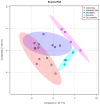Metabolomics Provide Sensitive Insights into the Impacts of Low Level Environmental Contamination on Fish Health-A Pilot Study
- PMID: 31935843
- PMCID: PMC7022837
- DOI: 10.3390/metabo10010024
Metabolomics Provide Sensitive Insights into the Impacts of Low Level Environmental Contamination on Fish Health-A Pilot Study
Abstract
This exploratory study aims to investigate the health of sand flathead (Platycephalus bassensis) sampled from five sites in Port Phillip Bay, Australia using gas chromatography-mass spectrometry (GC-MS) metabolomics approaches. Three of the sites were the recipients of industrial, agricultural, and urban run-off and were considered urban sites, while the remaining two sites were remote from contaminant inputs, and hence classed as rural sites. Morphological parameters as well as polar and free fatty acid metabolites were used to investigate inter-site differences in fish health. Significant differences in liver somatic index (LSI) and metabolite abundance were observed between the urban and rural sites. Differences included higher LSI, an increased abundance of amino acids and energy metabolites, and reduced abundance of free fatty acids at the urban sites compared to the rural sites. These differences might be related to the additional energy requirements needed to cope with low-level contaminant exposure through energy demanding processes such as detoxification and antioxidant responses as well as differences in diet between the sites. In this study, we demonstrate that metabolomics approaches can offer a greater level of sensitivity compared to traditional parameters such as physiological parameters or biochemical markers of fish health, most of which showed no or little inter-site differences in the present study. Moreover, the metabolite responses are more informative than traditional biomarkers in terms of biological significance as disturbances in specific metabolic pathways can be identified.
Keywords: Platycephalus bassensis; amino acids; biomarkers; diet; energy metabolism; fatty acid metabolites; flathead; metals.
Conflict of interest statement
The authors declare no conflicts of interest.
Figures





References
-
- Southam A.D., Lange A., Hines A., Hill E.M., Katsu Y., Iguchi T., Tyler C.R., Viant M.R. Metabolomics Reveals Target and Off-Target Toxicities of a Model Organophosphate Pesticide to Roach (Rutilus rutilus): Implications for Biomonitoring. Environ. Sci. Technol. 2011;45:3759–3767. doi: 10.1021/es103814d. - DOI - PMC - PubMed
-
- Viant M.R. Metabolomics of aquatic organisms: The new omics on the block. Mar. Ecol. Prog. Ser. 2007;332:301–306. doi: 10.3354/meps332301. - DOI
-
- Jones O.A.H., Murfitt S., Svendsen C., Turk A., Hazel T., Spurgeon D.J., Walker L.A., Shore R.F., Long S.M., Griffin J.L. Comparisons of metabolic and physiological changes in rats following short term oral dosing with pesticides commonly found in food. Food Chem. Toxicol. 2013;59:438–445. doi: 10.1016/j.fct.2013.06.041. - DOI - PubMed
LinkOut - more resources
Full Text Sources
Miscellaneous

